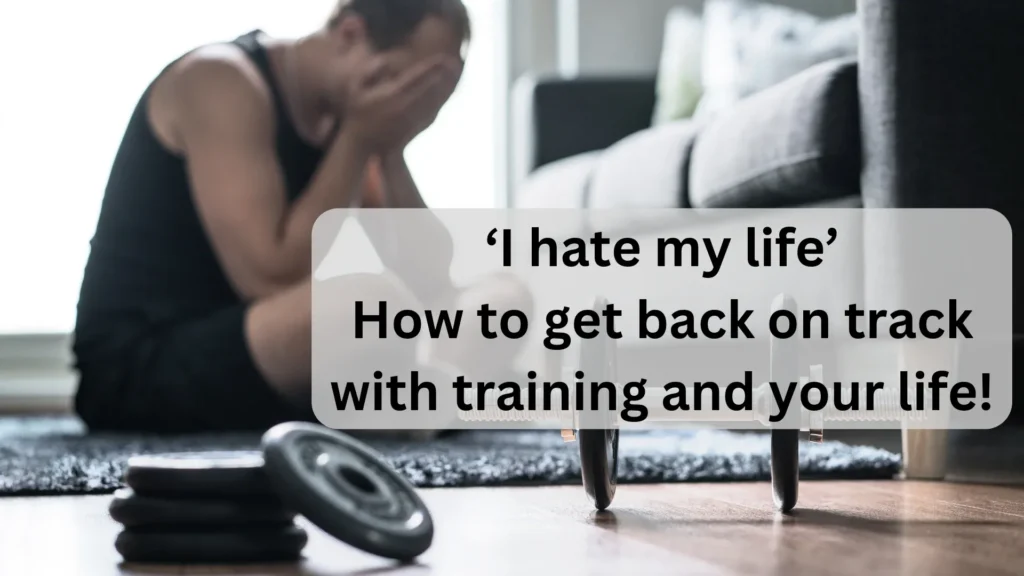
“I hate my life” is a phrase that carries a lot of weight.
It’s heavy, dark, and a bit scary.
Feeling like you’re at the bottom can be tough.
But here’s the thing: it’s also a sign.
A sign you’re ready for change.
Let’s dive into this feeling from my perspective as a sports psychologist. And figure out how to get back on track.
Both in training and in life!
I Hate My Life: What’s This Feeling? And Why Do I Have It?
This feeling is like hitting a wall.
It’s frustration, sadness, and a bit of anger all mixed together.
Why?
Because life’s tough.
Goals seem far away.
Maybe you’ve faced setbacks in sports, work, or relationships. It’s like the universe is saying, “Not today.”
But really, it’s your mind asking for a pause.
It’s normal.
We all get there.
This feeling is like being stuck in quicksand.
The more you fight it, the deeper you sink.
It’s complex, blending disappointment, fatigue, and even a sense of loss.
But why does it hit us?
There are a few reasons.
Firstly, expectation vs. reality.
You’ve set goals, dreamed dreams, but the scoreboard doesn’t match.
Whether it’s missing a personal best, facing continuous rejection, or navigating personal turmoil, the gap between where you are and where you want to be can feel immense.
Secondly, it’s about control, or rather, the lack of it.
Life throws curveballs like injuries, unexpected life changes or even global pandemics.
When our finely laid plans get derailed, it can leave us feeling powerless.
Burnout plays a big role, too.
Constantly pushing, without adequate rest or joy, leads to burnout.
It’s like running on empty.
Everything becomes a chore, including the things you once loved.
Isolation adds to the mix.
Feeling disconnected from friends, family, or teammates amplifies negative emotions.
We’re social creatures, and when we feel alone in our struggles, the hill seems steeper.
Lastly, there’s the comparison trap.
Scrolling through social media, it looks like everyone else is winning, except you.
This comparison can distort reality, making your situation seem worse than it is.
Understanding this feeling is the first step toward addressing it.
It’s not about erasing these feelings but recognizing them as indicators.
Indicators that it’s time to pause, reassess, and perhaps, change course.
What to Do If You Get This Feeling?
First, breathe.
Deep breath in, slow breath out.
Sounds simple, right?
But it’s a game-changer.
Next, break it down.
What’s really bugging you?
Is it your training not going as planned?
Relationship issues?
Feeling stuck?
Identify it!
Then, do something small. Something that makes you feel good.
Run. Read. Dance in your room. Small wins are still wins.
Here’s something not many talk about: add joy to your routine.
Yes, even your training routine.
Swap that grueling run for a dance class.
Play a sport you love just for fun.
Joy brings energy.
Energy brings motivation.
And motivation? That’s the golden ticket.
Here’s what I actually mean you should do, step by step:
- Acknowledge It
Pretending everything’s fine isn’t the solution.
Acknowledge your feelings. It’s okay to not be okay.
Acknowledgment is the first step to understanding and eventually overcoming these feelings.
- Break It Down
Zoom in on the specifics.
What exactly is triggering this feeling?
Identify aspects of your life or training that are causing distress.
Is it a particular event, an ongoing situation, or a general feeling of dissatisfaction?
Pinpointing the source can guide you to a solution.
- Find Your Quick Wins
Set up small, achievable goals.
Completing a task, no matter how small, can boost your mood and give you a sense of accomplishment.
It could be as simple as making your bed, going for a short walk, or preparing a healthy meal.
- Seek Variety
Change up your routine. If your training feels monotonous, try something new.
A different exercise, a new route for your run, or a fun workout challenge.
Variety can reignite your motivation and joy.
- Limit Social Media
Take a break from social media.
Constant comparison to others’ highlight reels can skew your perception of your own life.
Focus on your journey and progress, not someone else’s.
- Express Yourself
Write it down or talk it out.
Expressing your feelings can help lighten the emotional load.
Journaling or talking with a trusted friend can provide clarity and a new perspective.
- Practice Gratitude
Focus on what’s going right.
Start a gratitude journal.
Every day, write down three things you’re thankful for.
It could be as simple as a sunny day, a good workout, or a friend’s support.
Gratitude shifts focus from what’s missing to what’s present.
- Embrace Self-Care
Prioritize activities that nourish your body and soul.
Whether it’s reading a book, taking a long bath, meditating, or practicing yoga, self-care is crucial for mental health.
- Connect with Others
Reach out to friends, family, or join a community group.
Connection can reduce feelings of isolation and provide support.
Sometimes, just knowing you’re not alone in how you feel can be incredibly comforting.
- Give It Time
Healing and change don’t happen overnight.
Be patient with yourself.
It’s a journey with ups and downs.
Celebrate the small victories along the way.
Incorporating these steps doesn’t mean the negative feelings will disappear immediately, but they’re steps towards brighter days.
Remember, reaching out for help is a strength, not a weakness.
Whether it’s confiding in loved ones or seeking professional advice, support is key to navigating through tough times.

What to Do If the Feeling Doesn’t Go Away?
Talk to someone.
A friend, a coach, a psychologist.
Speaking up is brave.
It’s okay to not be okay.
If the cloud doesn’t lift, seek professional help.
Therapists and sports psychologists aren’t just for crises.
They’re like coaches for your mind. They can help you find strategies to cope and get back on track.
Besides friends and family, consider joining support groups or online communities where you can share experiences and feelings anonymously if preferred.
Hearing others’ stories and sharing your own can be incredibly validating and empowering.
A coach or therapist can offer new strategies to tackle your challenges.
They can help you understand your feelings and provide a fresh perspective. And introduce coping mechanisms that align with your individual needs.
Consistency is key so regular check-ins with someone you trust can provide a sense of stability and progress.
Make these conversations a part of your routine, whether it’s weekly or bi-weekly.
Seek Professional Help
Beyond traditional therapy, consider other forms of support such as cognitive-behavioral therapy (CBT), which can be particularly effective for addressing negative thought patterns.
Or even sports psychology for athletes struggling with motivation or performance anxiety.
With advances in technology, help is more accessible than ever.
Teletherapy can be a flexible and convenient option, allowing you to connect with professionals from the comfort of your home.
Finding the right therapist or coach and the most effective approach can take time.
Be open to trying different professionals until you find the right fit for your needs.
Embracing Imperfection
Life’s not perfect!
Your training won’t always be perfect!
And that’s perfectly okay.
Celebrate the effort, not just the achievements.
Laugh at the mishaps.
Smile at the struggles.
It’s all part of the journey.
Embracing imperfection helps lighten the load.
Challenge perfectionism by setting realistic goals and celebrate progress. Not just perfection.
Understand that setbacks are part of the process and offer valuable lessons, not failures.
Practice self-compassion through mindfulness or guided meditations focused on self-kindness.
Recognize that being imperfect is a part of being human.
When you catch yourself being overly critical, pause and try to reframe the thought in a more positive or forgiving way.
Ask yourself, “What would I say to a friend in this situation?”
The Power of a Break
Ever thought about taking a break?
Not giving up, but stepping back.
Sometimes, a break is what we need to see things clearly.
It’s not quitting!
It’s recharging!
Your mind, body, and soul will thank you.
A break can mean different things: a day off, a vacation, or a hiatus from certain activities or social media.
Clarify what you need a break from and set boundaries accordingly.
Use this time to explore interests outside of your usual routine.
This can provide new perspectives and invigorate your passion for returning to your regular activities.
Use the break as an opportunity to reflect on your life’s direction.
Assess what brings you joy and what drains you.
Sometimes, the best insights come when we’re not actively searching for them.
Connect With Nature
Get outside!
Nature has a way of healing and bringing perspective.
Whether it’s a walk in the park, a hike, or just sitting by the water, nature connects us to the bigger picture.
It’s a reminder that there’s beauty in the struggle.
Incorporate nature into your daily routine.
Even a short daily walk in a nearby park can have significant benefits for your mental health.
Practice mindfulness or meditation outdoors.
Focusing on the sights, sounds, and smells of nature can enhance the therapeutic effects.
Consider moving your workouts outdoors if possible.
Physical activity in natural settings, like hiking, cycling, or yoga in the park, can boost your mood and reduce stress.
Finding Your Why
Remember why you started.
Your “why” is your anchor!
It’s what keeps you grounded when the storms hit.
Write it down.
Talk about it.
Remind yourself of it every day.
Your “why” is your strongest weapon against “I hate my life.”
Saying “I hate my life” doesn’t mean you’ve given up. It means you’re ready for a change.
It’s a call to action!
Listen to it!
Embrace it!
Use it to fuel your journey!
With small steps, a bit of joy, and a lot of self-compassion, you’ll find your way back on track.
Remember, it’s not just about getting back to where you were. It’s about moving forward to where you want to be.
Taking these steps requires effort and sometimes a leap of faith, but remember, you’re not alone in this journey.
Every step, no matter how small, is a step towards a happier, healthier you.
Conclusion
Wrapping this up, remember, feeling like “I hate my life” is more common than you think.
It’s a sign you’re ready for change!
Taking small steps, embracing the journey, and seeking support can transform this feeling into a catalyst for growth.
And hey, it’s okay to ask for help!
That’s where the magic of growth begins.
Enter the Success Stories Community. It’s your go-to spot for bouncing back.
As a sports psychologist, I’m here to guide you.
Together, we’ll tackle those tough feelings.
You’ll get access to resources, strategies for high performance, and a community of folks who get it.
They’ve been in your shoes, ready to cheer you on.
So, let’s turn “I hate my life” into “I’m ready for what’s next.”
Join us, share your story, and discover how setbacks can lead to comebacks.
With the right tools and a supportive community, there’s no limit to what you can achieve.
Let’s kickstart this journey together!



